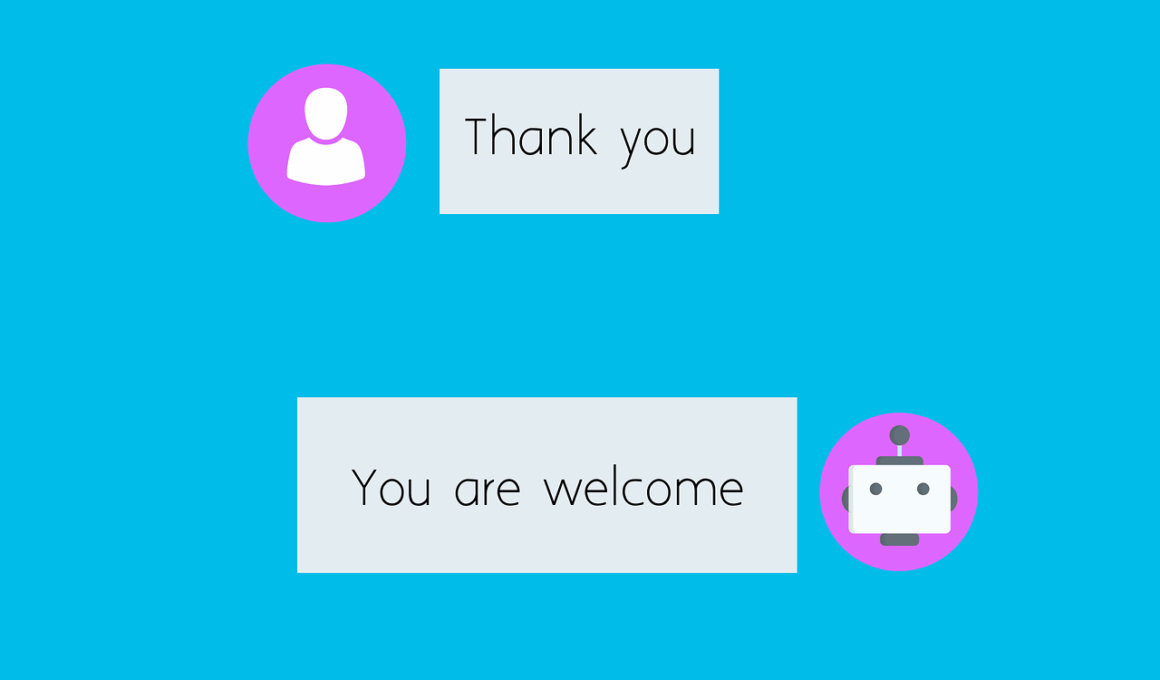The Role of Chatbots in Enhancing Insurance Customer Service
In today’s fast-paced digital economy, the integration of chatbots in the insurance sector is revolutionizing customer service. These intelligent agents can assist customers around the clock, answering queries and facilitating transactions with remarkable efficiency. Customers often have questions related to policy details, claim statuses, or coverage options. By addressing these inquiries promptly, chatbots enhance customer satisfaction while relieving stress on human agents. A typical chatbot can handle multiple conversations simultaneously, a feat unachievable by human operators. Additionally, they continuously learn from interactions, improving their responses and understanding over time. This automation leads to quicker resolutions and fulfills customer needs swiftly. Moreover, chatbots can predict customer inquiries based on previous interactions. They can also provide tailored insurance recommendations based on individual preferences and needs. This UI improvement not only engages customers but also leads to higher conversion rates for insurance providers. Increasing numbers of insurance companies are leveraging chatbots for their operations, and the benefits are profound. As technology continues to advance, chatbots promise further transformations in customer interaction within the insurance industry.
The ability of chatbots to streamline insurance processes is a game changer. By automating mundane tasks such as data entry, policy renewals, and claims processing, chatbots save valuable time for both insurers and customers. Traditional methods involve lengthy procedures often filled with paperwork and time delays. In contrast, chatbots provide instant services, allowing users to file claims directly through chat interfaces. Additionally, they enable customers to obtain quotes by simply conversing, thus reducing the time spent on research. Insurance companies report increased efficiency and productivity as a result of implementing these tools, manifesting a notable advantage over competitors. It’s essential to recognize that chatbots are not merely AI-driven programs; they represent a shift in how customer relationships are nurtured. With predictive analytics, they forecast and address common issues customers might face, personalizing support. Moreover, chatbots can navigate through vast databases, fetching precise information in real-time, resulting in informed decision-making. As these systems continue to evolve, they will become increasingly sophisticated, further enhancing their role within the insurance landscape.
Fostering Customer Engagement
Customer engagement is critical to retaining clients in the insurance landscape. Chatbots play a pivotal role in this regard by creating a more interactive and engaging experience. Unlike traditional customer service methods, chatbots offer a conversational approach where clients can freely ask questions and receive immediate feedback. This interactive nature promotes higher levels of engagement, keeping customers interested in their policies and coverage options. By utilizing a conversational interface, insurance providers can encourage a smoother communication channel where clients feel more heard and valued. Furthermore, chatbots can guide customers through the complexities of insurance policies, ensuring they understand what they are purchasing. Such guidance helps demystify complicated jargon often associated with insurance products. As users interact more with the bots, they build a sense of trust, essential for client retention. With features like personalized notifications for policy renewals and necessary claims reminders, chatbots can proactively engage customers. This capability ensures that clients are not only informed but are also more likely to maintain their policies. Chatbots, therefore, serve as a bridge to enhancing relationships between companies and their clients.
Moreover, the integration of chatbots provides extensive data collection opportunities. Each interaction generates valuable insights revealing customer preferences, behaviors, and pain points. These analytics empower insurance firms to tailor their marketing strategies effectively, providing customized offerings based on data-driven insights. The information gleaned from chatbot conversations can influence product development and strategic decisions, enhancing the insurer’s ability to respond to customer needs. Insurance organizations can segment their clientele more competently, ensuring each segment receives targeted communication. For instance, if a significant number of users inquire about specific types of coverage, insurers can assess market trends and adjust their offerings accordingly. Not only do chatbots assist in enhancing customer experiences, but they simultaneously function as an analytics tool for insurers. The combination of improved engagement and robust analytics fosters a culture of responsiveness and adaptation within the insurance industry. As analytics become ingrained in the operational framework, companies can align their processes better within the ever-evolving market landscape.
The Cost-Efficiency of Chatbots
Implementing chatbots in insurance operations also addresses the financial aspect of customer service management. By automating repetitive tasks, companies can minimize the costs associated with hiring and training human agents, significantly lowering operational expenses. Chatbots provide a scalable solution; as the volume of inquiries increases, bots can handle them without requiring additional resources. This efficiency allows companies to allocate funds more strategically towards improving other services or enhancing technology infrastructure. The sustained performance of chatbots across varied inquiries contributes to maintaining cost-efficiency levels consistently over time. Moreover, fewer human agents are necessary to manage high-demand periods, giving organizations the flexibility to optimize their workforce. Businesses can focus on training agents to handle complex issues that require human empathy and understanding, which chatbots currently cannot replicate. Consequently, this balance leads to a thriving ecosystem where both bots and humans coexist, enhancing the overall service quality provided to clients. As competition grows, those insurers who strategically implement chatbots will likely see a notable advantage in cost saving while retaining superior service experiences for their clients.
Another crucial aspect of chatbots is their role in improving customer satisfaction levels. Client satisfaction is paramount in the insurance sector, where competition is increasing daily. By offering prompt responses, chatbots ensure that clients are not kept waiting for assistance. Customer satisfaction largely hinges on the speed at which inquiries are resolved, and chatbots excel in this domain. Providing immediate answers to frequently asked questions frees clients from frustrations tied to traditional service lines. This reduction in wait times directly correlates with improved satisfaction rates and fosters a positive image for the insurance provider. Moreover, chatbots work tirelessly without fatigue, ensuring continuous service availability. This round-the-clock operational capability ensures that clients in different time zones can seek help at their convenience. Additionally, an enhanced user interface designed for ease of interaction multiplies satisfaction, as customers find engaging with bots straightforward. The overall positive customer experience drives loyalty and enhances the chances of recommendations to potential new clients. As chatbots become increasingly central to insurance interactions, customer satisfaction rates are set to rise.
The Future of Chatbots in Insurance
Looking ahead, the prospects of chatbots in insurance are bright and promising. As natural language processing (NLP) and machine learning technologies continue to advance, chatbot capabilities will significantly expand. These advancements will allow chatbots to understand context in conversations, making interactions more human-like and effective. The future will likely see chatbots not only engage customers through text but also via voice interfaces, broadening accessibility and user preference. Enhanced predictive analytics will mean that bots can not only respond to user queries but anticipate them, offering solutions before the customer even realizes a problem exists. Additionally, integrating chatbots with other technologies like human agents and data systems will create cohesive customer journeys. This synergy will allow issues to be escalated seamlessly, ensuring clients receive the best service possible regardless of how they interact with the company. The trends indicate a shift towards hyper-personalization, where chatbots will draw on vast datasets to deliver customized experiences. Overall, the role of chatbots in the insurance industry is set to evolve into an indispensable asset that drives both efficiency and customer satisfaction.
In conclusion, the role of chatbots in insurance customer service encompasses numerous benefits like efficiency, engagement, cost-effectiveness, and higher satisfaction levels. It becomes evident that their integration is not merely an option but a necessity. As technology progresses, these digital assistants will continue to adapt and refine their functions, creating uses far beyond basic customer inquiries. Chatbots will increasingly become integral in shaping customer experiences and expectations within the industry, setting new standards for service delivery. Insurers leveraging chatbots can reap the rewards of enhanced communication, allowing their human agents to focus on more intricate tasks. Embracing chatbot technology now will undoubtedly position insurers favorably in a rapidly evolving market landscape. The versatility and potential of chatbots present a compelling narrative that portrays their growing importance within the sector. Companies that prioritize innovation through tools like chatbots are positioning themselves for sustained success in an increasingly competitive field. Ultimately, enhancing customer service through chatbot technology will define the future trajectory of insurance businesses, ensuring relevant and engaged customer relationships.


